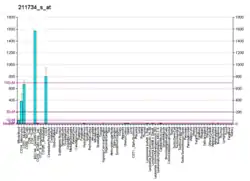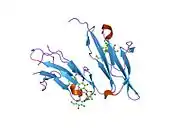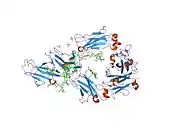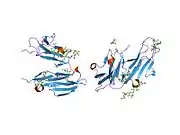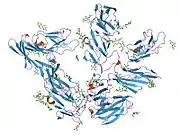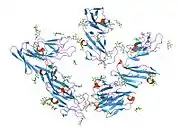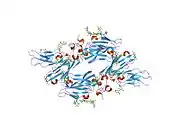| FCER1A | |||||||||||||||||||||||||||||||||||||||||||||||||||
|---|---|---|---|---|---|---|---|---|---|---|---|---|---|---|---|---|---|---|---|---|---|---|---|---|---|---|---|---|---|---|---|---|---|---|---|---|---|---|---|---|---|---|---|---|---|---|---|---|---|---|---|
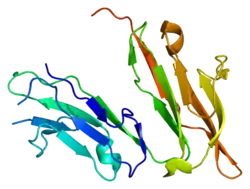 | |||||||||||||||||||||||||||||||||||||||||||||||||||
| |||||||||||||||||||||||||||||||||||||||||||||||||||
| Identifiers | |||||||||||||||||||||||||||||||||||||||||||||||||||
| Aliases | FCER1A, FCE1A, FcERI, Fc fragment of IgE receptor Ia | ||||||||||||||||||||||||||||||||||||||||||||||||||
| External IDs | OMIM: 147140 MGI: 95494 HomoloGene: 1516 GeneCards: FCER1A | ||||||||||||||||||||||||||||||||||||||||||||||||||
| |||||||||||||||||||||||||||||||||||||||||||||||||||
| |||||||||||||||||||||||||||||||||||||||||||||||||||
| |||||||||||||||||||||||||||||||||||||||||||||||||||
| |||||||||||||||||||||||||||||||||||||||||||||||||||
| |||||||||||||||||||||||||||||||||||||||||||||||||||
| Wikidata | |||||||||||||||||||||||||||||||||||||||||||||||||||
| |||||||||||||||||||||||||||||||||||||||||||||||||||
Fc fragment of IgE, high affinity I, receptor for; alpha polypeptide, also known as FCER1A, is a protein which in humans is encoded by the FCER1A gene.[5]
Function
The high affinity IgE receptor plays a central role in allergic disease, coupling allergen and mast cell to initiate the inflammatory and immediate hypersensitivity responses that are characteristic of disorders such as hay fever and asthma. The allergic response occurs when 2 or more IgE receptors are crosslinked via IgE molecules that in turn are bound to an allergen (antigen) molecule. A perturbation occurs that brings about the release of histamine and proteases from the granules in the cytoplasm of the mast cell and leads to the synthesis of prostaglandins and leukotrienes—potent effectors of the hypersensitivity response. The IgE receptor consists of 3 subunits: alpha (this protein), beta, and gamma; only the alpha subunit is glycosylated.[6]
References
- 1 2 3 GRCh38: Ensembl release 89: ENSG00000179639 - Ensembl, May 2017
- 1 2 3 GRCm38: Ensembl release 89: ENSMUSG00000005339 - Ensembl, May 2017
- ↑ "Human PubMed Reference:". National Center for Biotechnology Information, U.S. National Library of Medicine.
- ↑ "Mouse PubMed Reference:". National Center for Biotechnology Information, U.S. National Library of Medicine.
- ↑ Pang J, Taylor GR, Munroe DG, Ishaque A, Fung-Leung WP, Lau CY, Liu FT, Zhou L (December 1993). "Characterization of the gene for the human high affinity IgE receptor (Fc epsilon RI) alpha-chain". J. Immunol. 151 (11): 6166–74. doi:10.4049/jimmunol.151.11.6166. PMID 8245459.
- ↑ "Entrez Gene: FCER1A Fc fragment of IgE, high affinity I, receptor for; alpha polypeptide".
Further reading
- Gounni AS (2006). "The high-affinity IgE receptor (FcepsilonRI): a critical regulator of airway smooth muscle cells?". Am. J. Physiol. Lung Cell Mol. Physiol. 291 (3): L312–21. doi:10.1152/ajplung.00005.2006. PMID 16581830.
- Padlan EA, Helm BA (1993). "A modeling study of the alpha-subunit of human high-affinity receptor for immunoglobulin-E". Receptor. 2 (2): 129–44. PMID 1472946.
- Wang B, Rieger A, Kilgus O, et al. (1992). "Epidermal Langerhans cells from normal human skin bind monomeric IgE via Fc epsilon RI". J. Exp. Med. 175 (5): 1353–65. doi:10.1084/jem.175.5.1353. PMC 2119204. PMID 1533243.
- Küster H, Zhang L, Brini AT, et al. (1992). "The gene and cDNA for the human high affinity immunoglobulin E receptor beta chain and expression of the complete human receptor". J. Biol. Chem. 267 (18): 12782–7. doi:10.1016/S0021-9258(18)42344-7. hdl:2434/199851. PMID 1535625.
- Le Coniat M, Kinet JP, Berger R (1990). "The human genes for the alpha and gamma subunits of the mast cell receptor for immunoglobulin E are located on human chromosome band 1q23". Immunogenetics. 32 (3): 183–6. doi:10.1007/BF02114971. PMID 2146219. S2CID 23874749.
- Shimizu A, Tepler I, Benfey PN, et al. (1988). "Human and rat mast cell high-affinity immunoglobulin E receptors: characterization of putative alpha-chain gene products". Proc. Natl. Acad. Sci. U.S.A. 85 (6): 1907–11. Bibcode:1988PNAS...85.1907S. doi:10.1073/pnas.85.6.1907. PMC 279890. PMID 2964640.
- Kochan J, Pettine LF, Hakimi J, et al. (1988). "Isolation of the gene coding for the alpha subunit of the human high affinity IgE receptor". Nucleic Acids Res. 16 (8): 3584. doi:10.1093/nar/16.8.3584. PMC 336524. PMID 2967464.
- Yagi S, Yanagida M, Tanida I, et al. (1994). "High-level expression of the truncated alpha chain of human high-affinity receptor for IgE as a soluble form by baculovirus-infected insect cells. Biochemical characterization of the recombinant product". Eur. J. Biochem. 220 (2): 593–8. doi:10.1111/j.1432-1033.1994.tb18660.x. PMID 8125119.
- Pang J, Taylor GR, Munroe DG, et al. (1994). "Characterization of the gene for the human high affinity IgE receptor (Fc epsilon RI) alpha-chain". J. Immunol. 151 (11): 6166–74. doi:10.4049/jimmunol.151.11.6166. PMID 8245459.
- Walsh MT, Divane A, Whitehead AS (1996). "Fine mapping of the human pentraxin gene region on chromosome 1q23". Immunogenetics. 44 (1): 62–9. doi:10.1007/BF02602657. PMID 8613143. S2CID 6603996.
- Maurer D, Fiebiger S, Ebner C, et al. (1996). "Peripheral blood dendritic cells express Fc epsilon RI as a complex composed of Fc epsilon RI alpha- and Fc epsilon RI gamma-chains and can use this receptor for IgE-mediated allergen presentation". J. Immunol. 157 (2): 607–16. doi:10.4049/jimmunol.157.2.607. PMID 8752908.
- Garman SC, Wurzburg BA, Tarchevskaya SS, et al. (2000). "Structure of the Fc fragment of human IgE bound to its high-affinity receptor Fc epsilonRI alpha". Nature. 406 (6793): 259–66. doi:10.1038/35018500. PMID 10917520. S2CID 4419790.
- Nishiyama C, Hasegawa M, Nishiyama M, et al. (2001). "Cloning of full-length genomic DNA encoding human FcepsilonRI alpha-chain and its transcriptional regulation". Biochem. Biophys. Res. Commun. 284 (4): 1056–64. doi:10.1006/bbrc.2001.5079. PMID 11409901.
- Garman SC, Sechi S, Kinet JP, Jardetzky TS (2001). "The analysis of the human high affinity IgE receptor Fc epsilon Ri alpha from multiple crystal forms". J. Mol. Biol. 311 (5): 1049–62. doi:10.1006/jmbi.2001.4929. PMID 11531339.
- Shikanai T, Silverman ES, Morse BW, et al. (2002). "Sequence variants in the FcepsilonRI alpha chain gene". J. Appl. Physiol. 93 (1): 37–41. doi:10.1152/japplphysiol.00993.2001. PMID 12070183. S2CID 84256219.
- Sada K, Miah SM, Maeno K, et al. (2002). "Regulation of FcepsilonRI-mediated degranulation by an adaptor protein 3BP2 in rat basophilic leukemia RBL-2H3 cells". Blood. 100 (6): 2138–44. doi:10.1182/blood-2001-12-0340. PMID 12200378.
- Takahashi K, Nishiyama C, Ra C (2003). "Transcriptional regulation of the human high affinity IgE receptor alpha-chain gene". Mol. Immunol. 38 (16–18): 1193–9. doi:10.1016/S0161-5890(02)00062-7. PMID 12217383.
- Vangelista L, Cesco-Gaspere M, Lamba D, Burrone O (2002). "Efficient folding of the FcepsilonRI alpha-chain membrane-proximal domain D2 depends on the presence of the N-terminal domain D1". J. Mol. Biol. 322 (4): 815–25. doi:10.1016/S0022-2836(02)00853-7. PMID 12270716.
- Strausberg RL, Feingold EA, Grouse LH, et al. (2003). "Generation and initial analysis of more than 15,000 full-length human and mouse cDNA sequences". Proc. Natl. Acad. Sci. U.S.A. 99 (26): 16899–903. Bibcode:2002PNAS...9916899M. doi:10.1073/pnas.242603899. PMC 139241. PMID 12477932.
- Hasegawa M, Nishiyama C, Nishiyama M, et al. (2003). "Regulation of the human Fc epsilon RI alpha-chain distal promoter". J. Immunol. 170 (7): 3732–8. doi:10.4049/jimmunol.170.7.3732. PMID 12646639.




